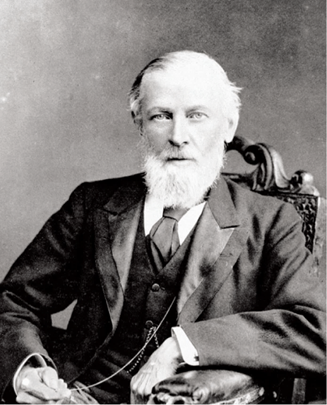A Manual on Diseases of the Nervous System (1886), Dr. William Gowers
By Luke Denney

Dr. William R. Gowers was born in London in 1845. His mother and father, neither of whom practiced medicine, both died while William was young. At the behest of his aunt, he became the apprentice to a physician, and eventually became the protégé and secretary of a London Physician named William Jenner [3]. After becoming a physician, Gowers kept an extremely detailed log of his cases and experiences while working as a neurologist. During this time, he made several key discoveries in the field which would eventually be detailed in the publication A Manual on Diseases of the Nervous System.
The name Gowers might sound familiar because of the eponymous Gowers’ sign and Gowers’ tract. Gowers’ sign is a description of how children with muscular dystrophy might stand from a squatting position, and Gowers’ tract is another name for the ventral spinocerebellar tract of the spinal cord, which was first discovered by Gowers. He was also the first to describe the patellar reflex as a “knee-jerk” [4]. All these descriptions are present within Gowers’ manual, which remained in use as a medical textbook for several decades following its publication, and after Gowers’ death in 1915.
A Manual of Diseases of the Nervous System is, at its heart, a medical textbook. Both volumes contain sections detailing the structures of different nervous system organs and the symptoms of their underlying pathologies. The first volume is focused primarily on diseases of the peripheral nervous system and spinal cord, while the second volume is focused almost exclusively on the brain and its diseases. Also contained within the text are several diagrams of different components of the nervous system. These drawings were created by Gowers himself and they possess an extremely high level of detail and accuracy [5]. Paired with these diagrams are Gowers’ writings about each system. Each section of the book is filled with details about its respective aspect of the nervous system, based on Gowers’ own research and case studies, made possible by the extensive journals he kept that described his medical practice over the years [6]. Gowers’ work reads not just as the extensive lived experience of an expert on the nervous system, but as the expert of his time.
Gowers stated that his goal for the textbook was to try and encapsulate as much knowledge of neurology and neuropathology as possible into one text. The text was designed for use by neurology students and practitioners as a quick reference in study and practice. This had not been truly attempted by the 1880s as, even then, the field of neurology was extremely broad; and within this breadth, each subject itself was immensely complex [7]. However, Gowers’ unique and concise writing style, presented alongside with his drawings, facilitated his ambitious goals for the manual.
While the field of neurology has expanded well beyond the knowledge contained in A Manual on Diseases of the Nervous System, it is still easy to understand how it retained its prized status for so long. While Gowers died of pneumonia in 1915, he went on to become one of the most frequently cited neurologists of the 20th century, due in no small part to his manual. The book itself is not a particularly fun read with its dry, academic tone; however, the value of the knowledge presented is not lost on the reader. It is truly a fascinating snapshot of medical knowledge in the 19th century.
(This post was written for the course HIST H364/H546 The History of Medicine and Public Health. Instructor: Elizabeth Nelson, School of Liberal Arts, Indiana University, Indianapolis).
References:
[1] Kate Vernon, "Sir William Richard Gowers (1845-1915)," Friends of Lawnswood Cemetery, accessed November 14, 202, https://friendsoflawnswoodcemetery.org.uk/sir-william-richard-gowers-1845-1915.
[2] "Obituary: Sir William Gowers, M.D., F.R.C.P., F.R.S., Consulting Physician to University College Hospital And To The National Hospital For The Paralysed And Epileptic, London. The British Medical Journal, vol. 1, no. 2836 (1915), 828. https://www.jstor.org/stable/25313581.
[3] K.L. Tyler, “William Richard Gowers (1845-1915).” Journal of Neurology, vol. 250, no. 8 (2003), 1012. https://doi.org/10.1007/s00415-003-1154-5.
[4] "Obituary,” 828.
[5] Gowers, A Manual of Diseases of the Nervous System, Philadelphia: P. Blakiston Son & Co., 1895.
[6] Tyler, 1013.
[7] Ibid.